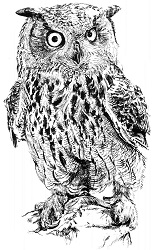
Scientific Name: Bubo bubo
Named ‘eagle’ owl for its large size, the Eurasian Eagle-owl is one of the largest owls in the world. A relative of the Great Horned Owl, the Eagle-owl has more pronounced plumicorns (ear tufts), large orange eyes, and an overall more ochre color. The plumage is buffy-brown, paler on the underparts, and heavily mottled and streaked with black, with fine barring on the belly and flanks, and dark bars on the wings and tail. The throat is white and is used in intraspecific communication, as a visual signal associated with vocal displays. The beak is black, and the legs and large, powerful toes are fully feathered buffy-white. There are a number of subspecies, whose appearance varies somewhat in size, color, and the amount of black barring/streaking.
Male
Length: 23 – 29″
Wingspan: 4.5 – 5.8′
Weight: 3.3 – 6.2 lb.
Female
Length: 23 – 29″
Wingspan: 4.5 – 5.8′
Weight: 3.9 – 9.2 lb.
This owl is endangered in many parts of Europe mostly due to persecution by humans. Protected by laws in most countries where it is found, they still suffer persecution, but have been recovering in some European countries. It is classified as Least Concern (LC) on the IUCN Red List and listed on Appendix II of CITES. Little detailed data is available on Asian populations. The Euroasian Eagle-owl has recovered to some extent in Europe as a result of improved protection, extensive reintroduction / restocking programs, and an increased food supply due to clear-felling and the proliferation of refuse dumps, with the resulting increases in rats and other rodents. Conservation measures recommended include protecting its habitat from development and extensive logging, as well as action to prevent collisions with power lines. Breeding pairs in Britain are thought to represent escapes from captivity, and it has been recommended that the potential impact of this large bird of prey on native wildlife be assessed.
Found in mountains and forests with cliffs and rocky areas, usually nesting on cliff ledges. In cities, have been seen hunting on rodents in landfills – risking poisoning from ingested toxins and getting entangled in waste. This owl usually inhabits natural rocky areas with cliffs and ravines, as well as quarries and buildings, patches of woodland or scattered trees. It also occurs in open forest, taiga, wooded steppe, semi-desert, and farmland with suitable rocky areas, and can be found at elevations of up to about 6500 ft in Europe and close to 15,000 ft in Central Asia and the Himalayas. Recently, this species has started to colonize urban habitats and is now breeding in several towns in Europe.
Hunting is typically from an open perch or in flight. Eagle-owls will eat almost anything that moves – from beetles to roe deer fawns. The major part of their diet consists of mammals (e.g., voles, rats, mice, foxes, hares), but birds of all kinds are also taken, including crows, ducks, grouse, seabirds, and even other birds of prey (including other owls). Other prey taken include snakes, lizards, frogs, fish (by plunging into water), and crabs. The most common type of prey depends largely on relative availability, but is usually voles and rats. In some coastal areas, they have been known to feed mainly on ducks and seabirds.
A deep, resonant hoot, stressed at the beginning and dropping at the end: “UH-hoo, UH, hoo.” The female has a higher pitch than the male. When disturbed or aggressive, a bill clack is given by both sexes.
On cliff ledges, caves, or unused nests of other large birds. Like most owls, they do not construct a nest. The Eurasian Eagle-owl is thought to be highly sensitive to disturbance, particularly during incubation, which may cause adults to abandon eggs and even small young.
Human persecution, collisions with power lines and vehicles. Pesticide poisoning also causes problems when owls ingest poisoned rodents. The Eurasian Eagle-owl underwent a significant decline in Europe during the 20th century, due mainly to human persecution. Pesticide use and poisoning from mercury seed-dressings have also been a problem, as have collisions with vehicles, barbed wire and power lines. In addition, diseases such as myxomatosis and rabbit hemorrhagic disease have decimated rabbit populations in some areas, with severe effects for the Eagle-owl population. Although the species has now recovered to some extent, and is not currently considered globally threatened, illegal persecution still occurs, and the population remains below its former levels.
With one of the largest range of any Eagle-owl, the Euroasian Eagle-owl is found from Portugal, and a small region in North Africa eastward through Europe – along the Mediterranean and in the Scandinavian countries. Absent or rare from mainland western European countries and the United Kingdom. More common in Scandinavia through Siberia, and the Caucus Mountain region, northern India and Mongolia, and as far east as China and Korea. Rare in the northern islands of Japan.

